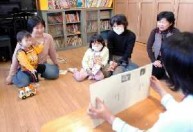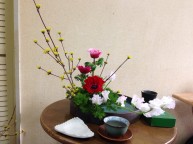Ikebana, or Kado (花道), the way of flowers, teaches me more than simply how to arrange flowers. It is a discipline through which Japanese people express their philosophy of life as well as their culture.
From my experience, simplicity seems to be method towards attaining beauty and perfection in ikebana. Whenever my ikebana sensei, Ishikawa-sensei, fixes my work, she always mentions that if I think a branch, a few buds, or even multiple leaves are unnecessary to the form, I must not hesitate to cut them out. In order to reveal what is important, one should eliminate any distractions. I find this philosophy very enticing, and actually practical, as it helps me gain determination carrying out my intention.
Interestingly, although ikebana may seem entirely like a creative expression, within its core lies a set of rules expected to be followed. Depending on the season, only certain flowers are chosen to be arranged. As the meaning of each flower varies, certain ones are meant for certain events. In addition, practitioners must sit in seiza form, hold their scissors properly, and cut the stem at the right angle. Then comes the rules of arranging a specific style itself. The length of the stem, the direction and angle of the flower, and the vessel used vary depending on what style the practitioner chooses. This is Saga Goryu’s approach to achieve 「花を知り、花と語らう、その心と技」.
Such rules, I believe, are to help the practitioner reach simplicity in the final work easier.
However austere my description of practicing ikebana may sound, my experience with ikebana, in fact, teaches me how to be happy. Through hard work and complicated rules, the final work is a simple expression of achievement. Then with some tea and sweets, we reflect on our work, on the process we have been through, and be content with a simple flower in the centre.
I also found a contradiction between my expectation and reality while practicing at sensei’s house. I’ve always imagined a serene setting with high concentration, but there were a lot of interactions among the senpais during practice. In addition to admiring and commenting on the work after someone finishes arranging, the conversations between senpais revolve around daily life things as well.
My experience with ikebana through doing CIP has been a combination of both modern and traditional Japan. While the teachings are strict, the environment within the sensei’s house is completely casual. It is amazing to see both happening at the same time and place.



